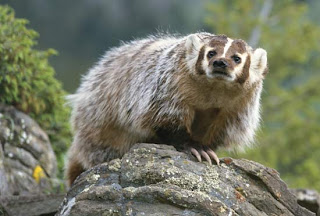 |
| What A Lovely Creature! (Source) |
American Badgers are relatively large Mustelids. They can grow as large as 3ft in length and weight over 25lbs. They have flat bodies, and short, stocky legs that are used for some serious digging. They vary in overall color, but all Badgers have a very distinctive face with a white chin, black patches, and a white stripe that extends all the way down the back. They have excellent senses of sight, smell, and hearing, which are all used to search for prey. Badgers do most of their digging in order to locate and pursue prey, which includes various rodent species and ground nesting birds. In some areas, Badgers and Coyotes have a strange working relationship. Coyotes cannot dig and Badgers cannot chase, and by hanging out near each other both can benefit. It has been found that Coyotes are capable of catching a third more prey when working with a Badger.
 |
| So Majestic! (Source) |
Badgers are tough little guys and have few natural predators. While they will rarely pick a fight, if a Badger is provoked it can be a formidable fighter and can also emit a harsh musk to ward off attackers. There are anecdotes of Badgers fighting off pairs of Coyotes and being able to outdig men with shovels.
And not only are they awesomely fearsome... but they have an adorable side as well! Oh, and Teddy Roosevelt kept one as a pet, named Josiah. Not recommended, but awesome.
Methinks I might just visit the Badger at the Zoo today. Awesome.
Hey, it's my birthday today too! Happy Birthday!
ReplyDeleteWow, small world! happy birthday to you too!
ReplyDelete